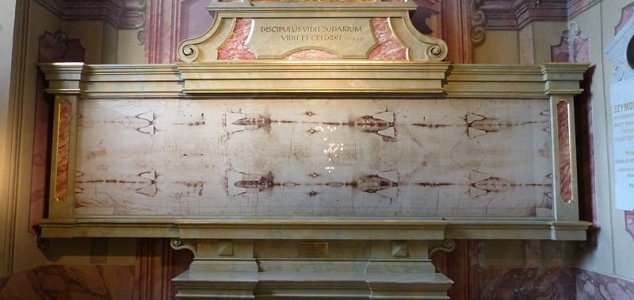Does the Turin Shroud show the face of the Fisher King ?
March 15, 2022

The Turin Shroud still remains an important religious relic. Image Credit: CC 3.0 Mogadir
Anthropologist David Akins believes that the world-famous relic may have actually been made in England.
The famous shroud, which many believe to be the burial cloth of Jesus himself, has been the subject of debate for years.
Radiocarbon-dating has suggested that the shroud is not actually from the time of Jesus at all but from the medieval period, however conflicting studies and opinions have made it difficult to reach a definitive conclusion over its origins and millions of people continue to believe that it really does bear the image of Christ.
Now according to historian David Akins, the shroud was never used to wrap the body of Jesus (or any other body for that matter) and was in fact created in Burton, England.
In the early 14th-Century, he argues, a life-size statue of the Fisher King was created and put on display in Burton Abbey until reconstruction work necessitated that it be placed in storage.
"Then it was retrieved and placed back on display," he said. "However, when the monks came to unwrap it, they noticed that the alabaster had reacted with chemicals in the mustiness of the cellar and left an image of the Fisher King on the old linen cloth."
"This is where the story of the Turin Shroud begins."
"No doubt one of the monks noticed a similarity between the features of the Fisher King impregnated onto the cloth and those of Jesus Christ and came up with a plan to present it as the shroud of Christ himself."
"The shroud of Christ would have commanded an exceptionally high price as a relic in the 14th-Century. I believe the quick-thinking monks saw an opportunity to make a fortune and decided to sell the cloth to the highest bidder."
Source: Staffordshire Live
https://www.unexplained-mysteries.com/news/356249/does-the-turin-shroud-show-the-face-of-the-fisher-king
Thanks to: https://www.unexplained-mysteries.com
March 15, 2022

The Turin Shroud still remains an important religious relic. Image Credit: CC 3.0 Mogadir
Anthropologist David Akins believes that the world-famous relic may have actually been made in England.
The famous shroud, which many believe to be the burial cloth of Jesus himself, has been the subject of debate for years.
Radiocarbon-dating has suggested that the shroud is not actually from the time of Jesus at all but from the medieval period, however conflicting studies and opinions have made it difficult to reach a definitive conclusion over its origins and millions of people continue to believe that it really does bear the image of Christ.
Now according to historian David Akins, the shroud was never used to wrap the body of Jesus (or any other body for that matter) and was in fact created in Burton, England.
In the early 14th-Century, he argues, a life-size statue of the Fisher King was created and put on display in Burton Abbey until reconstruction work necessitated that it be placed in storage.
"Then it was retrieved and placed back on display," he said. "However, when the monks came to unwrap it, they noticed that the alabaster had reacted with chemicals in the mustiness of the cellar and left an image of the Fisher King on the old linen cloth."
"This is where the story of the Turin Shroud begins."
"No doubt one of the monks noticed a similarity between the features of the Fisher King impregnated onto the cloth and those of Jesus Christ and came up with a plan to present it as the shroud of Christ himself."
"The shroud of Christ would have commanded an exceptionally high price as a relic in the 14th-Century. I believe the quick-thinking monks saw an opportunity to make a fortune and decided to sell the cloth to the highest bidder."
Source: Staffordshire Live
https://www.unexplained-mysteries.com/news/356249/does-the-turin-shroud-show-the-face-of-the-fisher-king
Thanks to: https://www.unexplained-mysteries.com






 Sat Mar 23, 2024 11:33 pm by globalturbo
Sat Mar 23, 2024 11:33 pm by globalturbo

